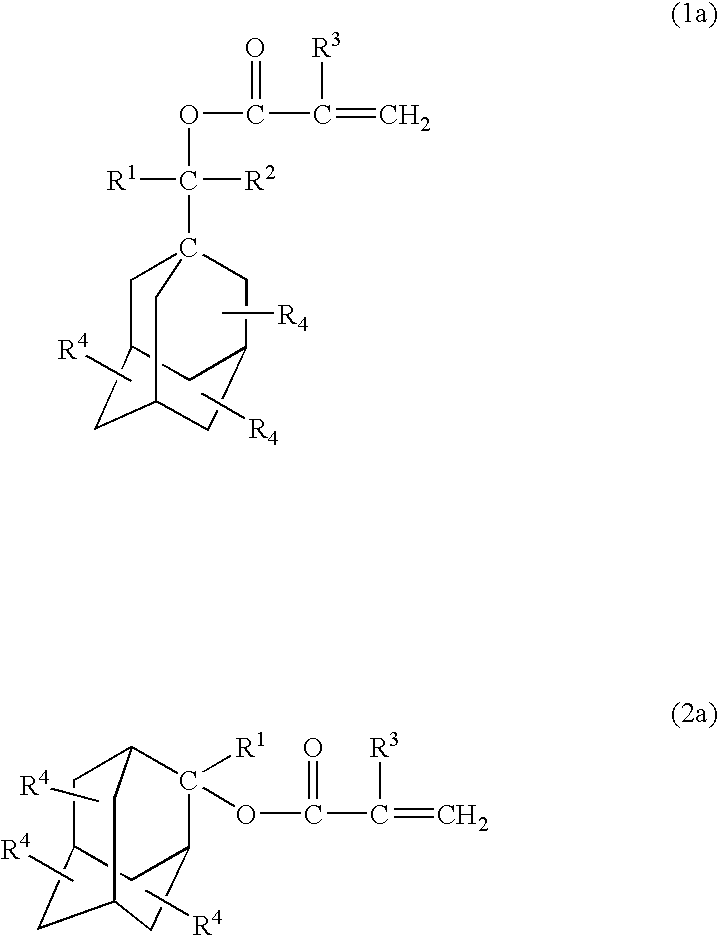Acid-sensitive compound and resin composition for photoresist
a resin composition and compound technology, applied in the field of acid-sensitive compound and resin composition for photoresist, can solve the problems of crack formation, increased peeling of pattern, and inability to form fine line definition patterns, etc., to achieve high sensitivity and etching resistance, good reproducibility, and high accuracy
- Summary
- Abstract
- Description
- Claims
- Application Information
AI Technical Summary
Benefits of technology
Problems solved by technology
Method used
Image
Examples
example 1
[0147] (1) Hydroxylation
[0148] To a solution of adamantan-1-yl-ethan-1-one (1 mol) in absolute tetrahydrofuran was added a solution of isopropylmagnesium iodide (iso-C.sub.3H.sub.7MgI) (1.2 mols) in absolute diethyl ether dropwise, and the mixture was stirred at 10.degree. C. for 6 hours to provide 1-(1-hydroxy-1,2-dimethylpropyl) adamantane.
[0149] (2) Esterification
[0150] A mixture of 1-(1-hydroxy-1,2-dimethylpropyl)adamantane obtained above (1.00 mmol), samarium iodide (SmI.sub.2) (0.10 mmol), isopropenyl acrylate (1.1 mmols) and dioxane (2 mmols) was stirred at 50.degree. C. for 6 hours. Analysis by gas chromatography revealed the formation of 1-(1-acryloyloxy-1,2-dimethylpropyl)adamantane of the following formula (yield 90%) in the reaction mixture.
[0151] Mass spectrum: [M] 276, 261, 218, 147, 135. 10
[0152] (3) Polymerization
[0153] A monomer mixture (100 parts by weight) of the obtained 1-(1-acryloyloxy-1,2-dimethylpropyl)adamantane (50 weight %), methyl methacrylate (10 weight ...
example 2
[0154] (1) Hydroxylation
[0155] A mixture of 1-(1-acryloyloxy-1,2-dimethylpropyl)adamantane (10 mmols), NHPI (2 mmols), acetylacetonatocobalt (Co(AA).sub.2) (0.1 mmol) and acetic acid (25 ml) was stirred in an oxygen atmosphere at 75.degree. C. for 6 hours to provide 1-hydroxy-3-(1-acryloyloxy-1,2-dimethylpropyl)a-damantane of the following formula (yield 78%).
[0156] Mass spectrum of hydroxyl-containing compound: [M] 292, 277, 233, 162, 145, 133. 11
[0157] (2) Polymerization
[0158] Using 1-hydroxy-3-(1-acryloyloxy-1,2-dimethylpropyl)adamantane in lieu of 1-(1-acryloyloxy-1,2-dimethylpropyl)adamantane, Step (3) of Example 1 was otherwise repeated to provide a copolymer.
example 3
[0159] (1) Introduction of a Carboxyl Group
[0160] To acetic acid (25 ml) were added adamantan-1-yl-ethan-1-one (1-acetyladamantane) (10 mmols), NHPI (1 mmol) and Co(AA).sub.2 (0.005 mmol), and the mixture was stirred at 60.degree. C. for 6 hours in reactor with a gas pack inflated with a mixed gas (a mixed gas of carbon monoxide (2 L) and oxygen (0.5 L); pressure: 5 kg / cm.sup.2). As a result, 1-carboxyadamantan-3-yl-ethan-1-one was obtained at a conversion rate of 78% (yield 62%).
[0161] (2) Hydroxylation
[0162] Using 1-carboxyadamantan-3-yl-ethan-1-one in lieu of adamantan-1-yl-ethan-1-one, Step (1) of Example 1 was otherwise repeated to provide 1-carboxy-3-(1-hydroxy-1,2-dimethylpropyl)adamantane (yield 60%).
[0163] (3), (4) Esterification and Polymerization
[0164] Using 1-carboxy-3-(1-hydroxy-1,2-dimethylpropyl)adamantane in lieu of 1-(1-hydroxy-1,2-dimethylpropyl)adamantane, Steps (2) and (3) of Example 1 were otherwise repeated to provide the carboxyl group-containing compound of t...
PUM
| Property | Measurement | Unit |
|---|---|---|
| wavelength | aaaaa | aaaaa |
| wavelength | aaaaa | aaaaa |
| temperature | aaaaa | aaaaa |
Abstract
Description
Claims
Application Information
 Login to View More
Login to View More - R&D
- Intellectual Property
- Life Sciences
- Materials
- Tech Scout
- Unparalleled Data Quality
- Higher Quality Content
- 60% Fewer Hallucinations
Browse by: Latest US Patents, China's latest patents, Technical Efficacy Thesaurus, Application Domain, Technology Topic, Popular Technical Reports.
© 2025 PatSnap. All rights reserved.Legal|Privacy policy|Modern Slavery Act Transparency Statement|Sitemap|About US| Contact US: help@patsnap.com



